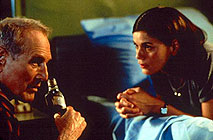|
|
|
|
Where
the Money Is
|
 |
|
The premise is intriguing: Henry (Paul Newman) is a thief, still technically jailed, who has had a stroke and for the moment resides in a home for the elderly. Carol (Linda Fiorentino), a nurse, cannot shake the suspicion that Henry is faking his near-comatose state – and thus perhaps planning another of the scams for which he is so famous. The script by E. Max Frye (Something Wild, 1986) lets us know very early on that Henry is indeed a master con-artist – with an enviable control of Tantric Buddhism and other methods of self-discipline. Once he reveals his true self to Carol – thus awakening in her a long-dormant thrill-seeking nature – he must also deal with her tough but troubled husband, Wayne (Dermot Mulroney). Henry's gleeful return to a criminal lifestyle blends associations of many former Newman roles, from Butch Cassidy and the Sundance Kid (1969) to The Color of Money (1986). But this is a resolutely lightweight escapade, despite a few moments of well-orchestrated tension and suspense. It is a whimsical, enjoyable, unostentatious film that, in the current movie climate, seems too good to merely end up on a television screen, and yet not spectacular enough to deserve a decent run at a cinema. It is a movie – like many these days – falling into a now deserted middle ground of production. UK-born director Marek Kanievska (Another Country [1984] and the underrated Less Than Zero [1987]) is one of those marginal figures who toils, all too rarely, in the margins of American production. Like Robert Mulligan or Uli Edel, his way of directing is elegant, pertinent and perfectly shaped to the specific material of each project – not designed to show off an unchanging signature style. Such solid professionalism and craftsmanship has, unfortunately, doomed him to near-anonymity. Where the Money Is offers the kinds of subtle pleasures that some audiences of yesteryear must have enjoyed in modest but intriguing B movies. The ensemble work by the actors is terrific; the story always moves along steadily; the overall tone, neither too dramatic nor too flippant, is expertly controlled in its modulations. This also means that the film contains nothing particularly striking or extreme: interesting possibilities in the rapport between Henry and Carol are glossed over, and the seed of a revenge plot is planted but then left to whither. However, those who lament that Hollywood no longer makes movies the way it used to might well enjoy the low-key vibe of Where the Money Is. MORE E. Max Frye: Amos & Andrew © Adrian Martin February 2001 |
![]()